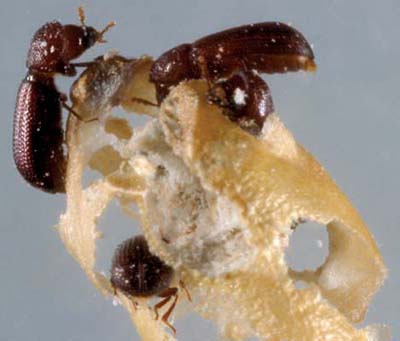
Adults lesser grain borer, Rhyzopertha dominica.
(Photographer: L.J. Buss, University of Florida)
The lesser grain borer feeds within whole grains, and infested grain may have a strong, sweet odor. It can eat its way into wood and paper boxes and may destroy book bindings. It has a worldwide distribution and is more common in warmer regions, such as the southeastern U.S. Corn, wheat and sorghum are the most common grains infested, but it also infests tobacco, nuts, beans, biscuits, cassava, cocoa beans, dried fruits, peanuts, spices, dried fish or meat.
The adult is dark brown to black in color and 3 mm long. It has a somewhat polished but roughened surface. It is among the smallest of the grain infesting beetles. The head is located under the prothorax and cannot be seen from above. The wing covers have rows of punctations. The antennae have a 3-segmented club with the club segments enlarged to one side. The female lays up to 500 eggs, singly or in clusters, and the larvae bore into the grain where they complete their development. Mature larvae are up to 3.2 mm long. They are whitish in color, except the head and claws which are darker. The life cycle can be completed in 25 days. The adults are strong fliers.
Images
To save the Web-optimized images shown below to your hard drive:
|
Click to access Display and Print quality images. |
|
Click to access Display and Print quality images. |
|
Click to access Display and Print quality images. |